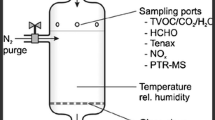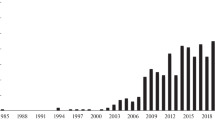Abstract
Lung cancer is a frequent cause of cancer-related deaths in the world. There is no valid screening process and this limits its detection to the late stages, with consequently high mortality rates. Volatile organic compounds (VOC) are chemical compounds (mainly the products of cell catabolism) found as gases in the human breath. Different methods have been developed to analyse VOCs and to compare them in healthy subjects and lung cancer patients. In this review, we summarise the different techniques used to analyse VOC. Many reports have been published with promising results similar to those achieved with accepted screening methods such as mammography. These methods show good perspectives on lung cancer screening.
Similar content being viewed by others
References
Jemal A, Siegel R, Ward E et al (2007) Cancer statistics, 2007. CA Cancer J Clin 57:43–66
Rossi A, Maione P, Colantuoni G et al (2005) Screening for lung cancer: new horizons? Crit Rev Oncol Hematol 56:311–320
Humphrey LL, Teutsch S, Johnson M (2004) Lung cancer screening with sputum cytological examination, chest radiography and computed tomography: an update for the US Preventive Task Force. Ann Intern Med 140:740–753
The International Early Lung Cancer Action Program Investigators, Henschke CI, Yankelevitz DF, Libby DM et al (2006) Survival of patients with stage I lung cancer detected on CT screening. N Engl J Med 355:1763–1771
Mulshine L (2005) New developments in lung cancer screening. J Clin Oncol 14:3198–3202
Mahadevia PJ, Fleisher LA, Frick KD et al (2003) Lung cancer screening with helical computed tomography in older adult smokers: A decision and cost effectiveness analysis. JAMA 289:313–322
Gordon SM, Szidon JP, Krotoszynski BK et al (1985) Volatile organic compounds in exhaled air from patients with lung cancer. Clin Chem 31:1278–1282
O’Neill HJ, Gordon SM, O’Neill MH et al (1988) A computerized classification technique for screening for the presence of breath biomarkers in lung cancer. Clin Chem 34:1613–1618
Phillips M, Herrera J, Krishnan S et al (1999) Variation in volatile organic compounds in the breath of normal humans. J Chromatogr B Biomed Sci Appl 729:75–88
Rahman I, MacNee W (1996) Role of oxidants/antioxidants in smoking-induced lung diseases. Free Radic Biol Med 21:669–681
Kneepkens CM, Lepage G, Roy CC (1994) The potential of the hydrocarbon breath test as a measure of lipid peroxidation. Free Radic Biol Med 17:127–160
Loft S, Poulsen HE (1996) Cancer risk and oxidative DNA damage in man. J Mol Med 74:297–312
Yu H, Xu L, Wang P (2005) Solid phase microextraction for analysis of alkanes and aromatic hydrocarbons in human breath. J Chromatograph B Biomed Sci Appl 826:69–74
Giardina M, Olesik LW (2003) Application of low-temperature glassy carboncoated macrofibers for solid-phase microextraction analysis of simulated breath volatiles. Anal Chem 75:1604–1614
Prado C, Marin P, Periago JF (2003) Application of solid-phase microextraction and gas chromatography-mass spectrometry to the determination of volatile organic compounds in end-exhaled breath samples. J Chromatogr A 1011:125–134
Libardoni M, Stevens PT, Waite JH, Sacks R (2006) Analysis of human breath samples with a multi-bed sorption trap and comprehensive two-dimensional gas chromatography (GC?GC). J Chromatogr B Anal Technol Biomed Life Sci 842:13–21
Sanchez JM, Sacks RD (2005) On-line multi-bed sorption trap for VOC analysis of large-volume vapor samples: injection plug width, effects of water vapor and sample decomposition. J Sep Sci 28:22–30
Gardner JW, Barlett PN (1999) Electronic noses: principles and applications. Oxford University Press, Oxford, UK
Nimmermark S (2001) Use of electronic noses for detection of odour from animal production facilities: a review. Water Sci Technol 44:33–41
Phillips M, Cataneo RN, Cummin AR et al (2003) Detection of lung cancer with volatile markers in the breath. Chest 123:2115–2123
Di Natale C, Macagnano A, Martinelli E et al (2003) Lung cancer identification by the analysis of breath by means of an array of non-selective gas sensors. Biosens Bioelectron 18:1209–1218
Machado RF, Laskowski D, Deffenderfer O et al (2005) Detection of lung cancer by sensor array analyses of exhaled breath. Am J Respir Crit Care Med 171:1286–1291
Phillips, M, Altorki N, Austin JHM et al (2007) Prediction of lung cancer using volatile biomarkers in breath. Cancer Biomarkers 3:95–109
Rahman I, Kelly F (2004) Biomarkers in breath condensate: a promising new noninvasive technique in free radical research. Free Radic Res 137:1253–1266
Gessner C, Kuhn H, Toepfer K et al (2004) Detection of p53 gene mutations in exhaled breath condensate of non-small cell lung cancer patients. Lung Cancer 43:215–222
Carpagnano GE, Foschino-Barbaro MP, Mule G et al (2004) 3p microsatellite alterations in exhaled breath condensate from patients with non-small cell lung cancer. Am J Respir Crit Care Med 172:738–744
Fontana RS, Sanderson DR, Woolner LB et al (1986) Lung cancer screening the Mayo program. J Occup Med 28:746–750
Pastorino U, Bellomi M, Landon C et al (2003) Early lung cancer detection with spiral CT and positron emission tomography in heavy smokers: 2-year results. Lancet 362:593–597
Author information
Authors and Affiliations
Corresponding author
Additional information
Supported by an unrestricted educational grant from Roche Farma S.A.
Rights and permissions
About this article
Cite this article
Belda-Iniesta, C., de Castro Carpeño, J., Carrasco, J.A. et al. New screening method for lung cancer by detecting volatile organic compounds in breath. Clin Transl Oncol 9, 364–368 (2007). https://doi.org/10.1007/s12094-007-0068-6
Published:
Issue Date:
DOI: https://doi.org/10.1007/s12094-007-0068-6




